Notes
Snowden in Moscow: “The More Photographed I Am…the More Dangerous my Situation”
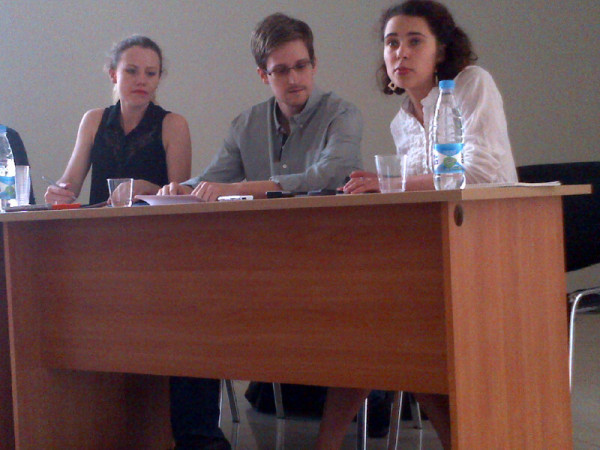 Photo of Snowden taken by @HRW‘s @TanyaLokshina in Moscow airport now. Meeting has started. http://twitpic.com/d2863z
Photo of Snowden taken by @HRW‘s @TanyaLokshina in Moscow airport now. Meeting has started. http://twitpic.com/d2863z
At first glance, it looked like Edward Snowden was wearing the same blue-gray button down dress shirt that he wore during his interview with Glenn Greenwald and Laura Poitras in that Hong Kong hotel room on June 6, which until now was essentially the only photograph we had of him. That already seems – as it must even more so for him – so long ago. Another continent. Another life. He had already made the decisive step to break with the NSA, but still had a passport, was still free.
Yet without anything else to go by, that image became ubiquitous around the world, reproduced thousands of times in print and online, on TV screens and LED billboard displays, turned into ironic artwork, Xeroxed for demonstrations in his support, truly gone viral. So the thirst for more images – more up-to-date images – has become palpable and unnerving. In a world where there are too many photographs, Snowden managed to remain publicly unseen throughout his flight to Russia and subsequent limbo at Sheremetyevo Airport. So much so that there was doubt if he was even really there.
This is the Snowden-messenger pic.twitter.com/4Qh5cBtV0A Photograph by Olaf Koens.
So, when he invited representatives from Human Rights Watch and Amnesty International to the airport, the response was explosive. Hundreds of journalists scrambled, and watched as airport staff with the prearranged sign marked “G9” (a joke on the G8?!?) led the guests through a service door. The scene was exactly what we would expect: the sense of high drama and expectation, the crush of people, the dark suits of burly male officials.
The moment of truth came once the meeting began. Tanya Lokshina of Human Rights Watch made the first photographs of Snowden since Hong Kong. She wrote, “The first thing I thought was how young he looks – like a school kid.” Upon closer inspection, Snowden’s shirt is not the one he wore in Hong Kong. This one has button-down collars; the other one did not. But it’s evident that either his sartorial taste runs quite narrowly — as befitting a classic “computer nerd” — or he’s very specifically controlling his image, or both. In response to a request that he make himself available for more photographs to the assembled media outside the conference room, Snowden said,
“The more photographed I am, understanding the technical capability that the US services have, the more dangerous my situation becomes.”
He’s presumably speaking about facial recognition technology, meaning that the more photos that are taken of him, the easier it will be to make a match if he goes incognito. And on the human detective level, more imagery in more diverse attire could give his pursuers a far clearer picture of his preferences, his available wardrobe, and his mannerisms and appearance in general. It’s pure speculation, of course, if wearing almost the same clothing is intended to limit the sense of what he might look like in disguise or it’s just consistent with the standard tradecraft of a CIA and NSA operative who avoided being photographed long before he went off the reservation.
“I feel safe in Russia”. More on http://www.delo.si pic.twitter.com/HTId0bKVgD Photograph by Polona Frelih.
No journalists were supposed to be admitted, but Polona Frelih of the Slovenian newspaper Delo joined them. In her article, she wrote that “the meeting was attended by 11 representatives of Russian humanitarian organizations and myself I spent there as a representative of one of them.” Austrian journalist Tanja Malle and I asked her on Twitter how she got into the meeting, to which she coyly responded, “I’ve spent a lot in time in Russia to get my way around ; – )” and then “I was there as a journalist. Not that anyone would know.”
She gave further insights on Snowden’s predicament. Frelih tweeted, “#Snowden is not phantom. Fragile, desperate” and then clarified, “#snowden looked like someone without daylight for long time but strong enough psychologically.” Answering questions about Sarah Harrison and Wikileaks, she wrote, “It’s obvious who is in charge. #wikileaks are the only ones he can count on now” and “S. Harrison is a bossy lady, probably has to be. I will talk first she said at the beginning.” Frelih’s photograph with the hand of Wikileaks crossing Snowden’s face shows this uneasy tension explicitly.
Some answers emerged from the meeting: that Snowden is in fact at the airport; that he continues to be well spoken and articulate, albeit under significant strain. Amnesty and HRW support his right to asylum, though it’s unclear what they can practically or realistically do to help him. His controversial alliance with Wikileaks is a fact for better or worse. As for assessing what kind of shape he’s in from these new photos, it’s hard to say whether his psychological and physical conditions are a glass half full, or half empty; very possibly both. Mostly, the exercise served to confirm accepted narratives rather then spring any surprises.
Old school journalism. http://instagram.com/p/brUx0GyrJv/# Photograph by Olaf Koens.
The waiting media – and the rest of us – will continue to wonder how Edward Snowden’s saga will play out. The latest Quinnipiac poll of Americans suggests that there’s been a shift in attitudes towards the balance between civil liberties and security, with 45% now believing that anti-terrorism programs have gone too far, compared to 25% several years ago, and that 55% consider Snowden a whistleblower rather than a traitor. How long it may take for there to be a shift in policy might be appropriately measured at the pace of that typewriter. Which, incidentally, is making a Snowden-inspired comeback in Russia’s Federal Guard Service (FSO) as a safer way to communicate than computers: They just put in an order for Triumph-Adlers from Germany!
— Alan Chin
h/t: Phelim Kine, Tanja Malle and Polona Frelih
————
A video of part of the meeting; full audio of the meeting: video: Tanya Lokshina from Human Rights Watch: video: Sergei Nikitin from Amnesty International.
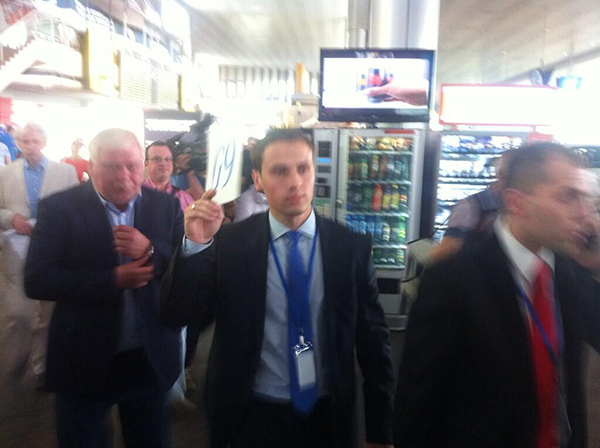
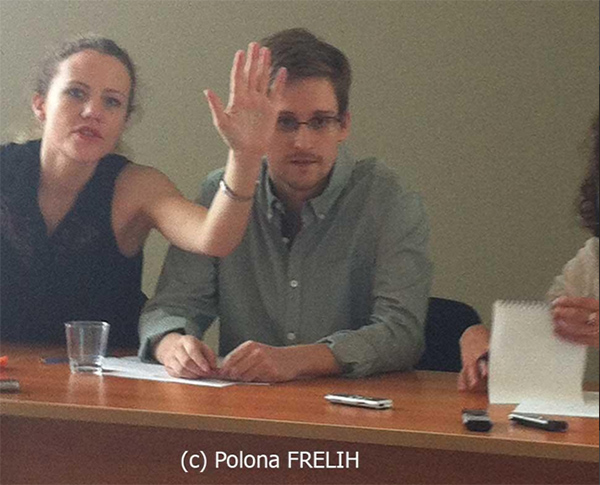
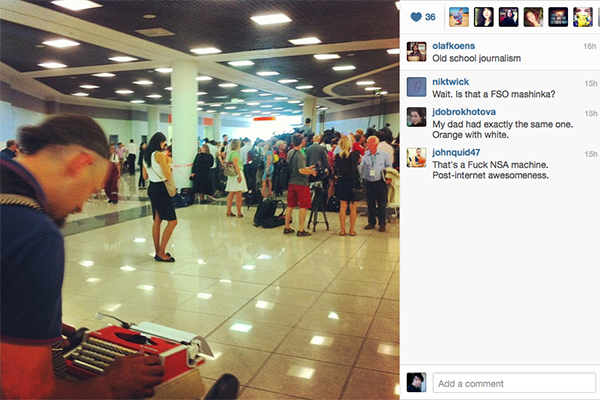
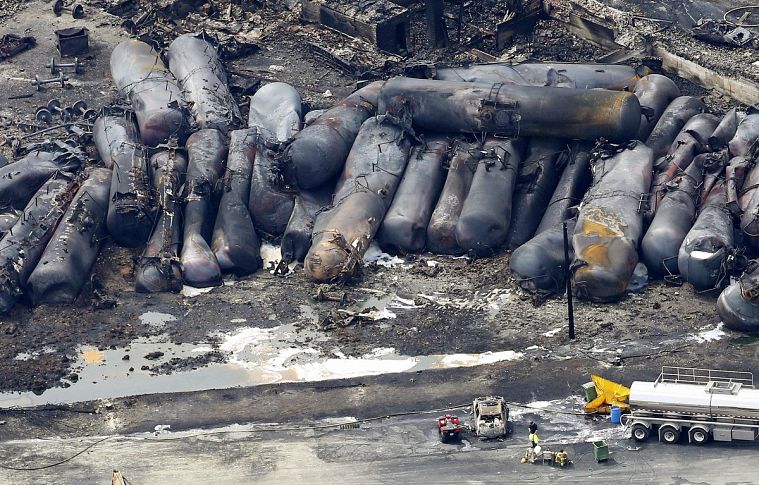
Reactions
Comments Powered by Disqus